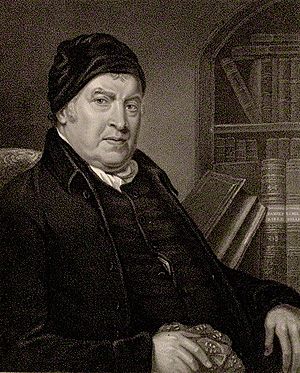James Godby facts for kids
James Godby (1767–1849) was a British artist who specialized in making pictures by engraving. This means he created images by carving designs into metal plates, which could then be used to print many copies. He lived in London in the early 1800s.
Who Was James Godby?
James Godby was born in 1767 and passed away in 1849. He was known for a special type of engraving called "stipple engraving." This method uses many tiny dots to create images, giving them a soft, textured look, much like a drawing made with a pencil.
Godby's Early Works
Godby started his career by creating portraits. One of his first known works was a picture of Edward Snape in 1791. Snape was a farrier, someone who cared for horses' hooves, for King George III. Godby made this engraving by copying a painting by another artist named Whitby.
He also created two large engravings based on paintings by Henry Singleton. These were called Adam bearing the Wounded Body of Abel and The Departure of Cain. They were published in 1799 and 1800. In 1810, he made a full-length portrait of Edward Wyatt, Esq., copying a painting by the famous artist Sir Thomas Lawrence.
Later Engravings
Later in his life, James Godby continued to create many engravings. He often copied works by other artists, like Friedrich Rehberg. Some of his later portraits included famous people such as Madame de Stael and Sir John Herschel. He also made a creative group picture called Bacchus's and Cupid's Vintage.
Godby's work was also featured in popular publications of his time. He created engravings for magazines like the Literary Magazine and a book called The Fine Arts of the English School. His detailed engravings helped share art with more people by making copies of paintings available.


